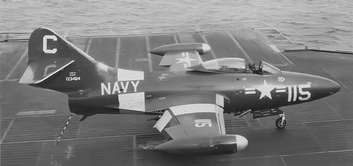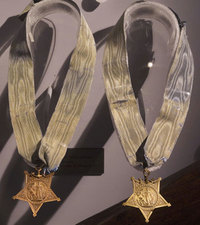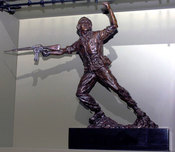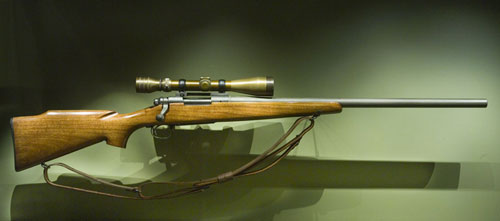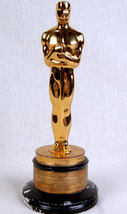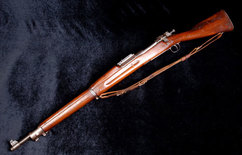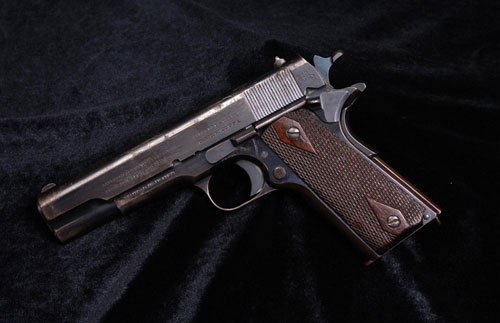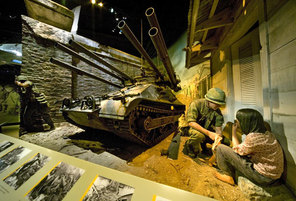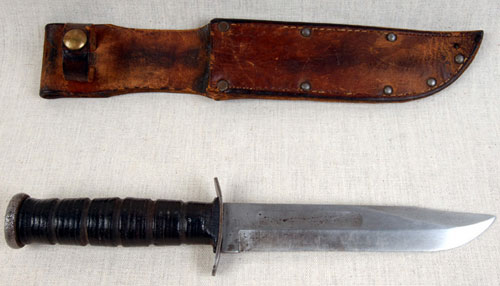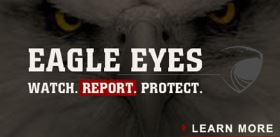Iconic Artifacts
Visitors to the National Museum of the Marine Corps will find approximately one thousand artifacts on display – from tactical aircraft to a small field ration can opener – each with their own story to tell. However, certain artifacts stand out because of their unique power to bring the past of the Corps to life. Below is a sampling of some of the many special iconic artifacts on display at the Museum.
Bell UH-1E Huey
The Bell UH-1 Huey helicopter is one of the most iconic aircraft of the Vietnam War. Known for is distinctive sound, the Huey served as a transport, aerial ambulance, flying control post and gunship. The UH-1E hanging above the Legacy Walk is the aircraft with which Marine Capt. Stephen W. Pless and his three-man crew heroically rescued the crew of a downed U.S. Army CH-47 Chinook on August 19, 1967, from overwhelming Viet Cong forces. After forcing the advancing enemy back with gun and rocket attacks, Pless landed and his crew fought hand-to-hand with the advancing Viet Cong to rescue the surviving Army helicopter crew members. With the additional Army helicopter crew members aboard dangerously overloading their own helicopter, Pless's crew jettisoned any unnecessary equipment helping Pless to coax the Huey into the air to deliver the wounded Army crew members to a field hospital. For his bravery under fire, Pless was presented with the Medal of Honor and his three crew members were awarded the Navy Cross.
Transferred from NAVAIR Display of the Bell UH-1E is sponsored by Bell Helicopter Located in the Legacy Walk |
Grumman F9F-2B PantherThe Grumman Panther was Marine Corps’ first widely used jet aircraft. Although outclassed by the Air Force’s F-86 Sabre or the Soviet MiG-15bis, the F9F-2 was an excellent ground attack aircraft and earned the admiration of the ground troops it supported in Korea. The Museum’s F9F-2B is one of two VMF-311 Panthers that flew the Marine’s first ever jet combat mission – an attack mission in support of beleaguered U.S. Army soldiers on December 10, 1950. Acquired from Mr. Arthur McDonnell Located in the Korean War Gallery |
Sergeant Major Daniel Daly's Medals of HonorOften called “the outstanding Marine of all time,” Sergeant Major Daniel J. Daly received Medals of Honor for his valorous actions during the Boxer Rebellion (August 1900) and the first Haitian Campaign (October 1915). Daly also fought in France during Would War I and is known for his immortal battle cry of “Come on you sons of bitches, do you want to live forever?”
Donated by Mr. Burton J. Loeb Display of SgtMaj Dan Daly’s Medals of Honor sponsored by Marine Military Expositions Located on the Legacy Walk |
The Mount Surbachi Flags
Perhaps the most important artifacts in the care of the National Museum of the Marine Corps are the pair of original American flags raised by the Marines on Mount Suribachi on 23 February 1945. The attack transport Missoula donated the smaller flag, raised by the Schrier Patrol on the summit. Landing Ship Tank (LST) 779, then unloading at Green Beach, donated the larger flag, raised later in the day and portrayed in the famed Joe Rosenthal’s photograph. Frayed by strong winds, the second flag flew from Suribachi for the balance of the battle for Iwo Jima.
To reduce exposure to harmful light, the two flags be displayed on a rotating basis. At all times, one of the two Mount Suribachi Flags will be on display at the National Museum of the Marine Corps. |
The Leftwich Trophy
Named in honor of Lieutenant Colonel William G. Leftwich, Jr., who was killed in Vietnam, this trophy is presented each year to the outstanding company grade Marine officer, through the bequest of Mr. Ross Perot. Mr. Perot conceived the idea for the trophy and commissioned Mr. Felix DeWeldon to sculpt the original statue.
Display of the Leftwich Trophy sponsored by H. Ross Perot Located in the Vietnam Gallery |
M-40A1 Sniper Rifle
Lance Corporal Charles Benjamin “Chuck” Mawhinney used this rifle during his service in Vietnam where he killed a confirmed 103 enemy soldiers (with an additional 216 probables) with this rifle. Discovered at Weapons Training Battalion, Marine Corps Base Quantico, in 1996, the weapon was retired from service and retrofitted to the configuration used by Lance Corporal Mawhinney during the Vietnam War.
|
The Tarawa OscarIn 1944, the Motion Picture Academy presented the Marine Corps this Oscar for its gritty documentary With the Marines at Tarawa. Graphic and shocking to American audiences, it was filmed by Marines of the 2nd Photographic Division and released on the order of President Franklin D. Roosevelt.
|
|
Wake Island M1903 Spring RifleThis rifle, much beloved by Marines, was the primary issue rifle for much of the first half of the 20th century, before being replaced by the M-1 Garand during World War II. Millions of these rifles were manufactured. This particular M1903 rifle was used by Marines defending the US naval outpost at Wake Island. Captured by the Japanese, it was subsequently recaptured later in the war when American forces liberated the island of Wake.
|
Major General John A. Lejeune's Overseas Cap
Marines serving in France during World War I needed headgear that was comfortable to wear but that could be easily stored. Modeled after a French hat, the overseas cap became a permanent item. Legendary Marine Corps Major General John A. Lejeune wore this one.
Donated by Mrs. John A. Lejeune |
Major General O.P. Smith's M1911.45 Pistol
This .45 caliber pistol was the mainstay of military issued side-arms for the US armed forces for over 70 years. The .45 pistol was carried by famed Marine Major General O.P. Smith through out his service during the Korean War as commander of the 1st Marine Division.
|
M50A1 Ontos Anti-tank VehicleDeveloped and rejected by the U.S. Army as an anti-tank vehicle, it was accepted for procurement by the Marines in 1955. Within a year, the Ontos was integrated into the armored units of the Fleet Marine Force. In Vietnam, its role soon shifted to direct fire support of ground troops. It was used in defense at Chu Lai and during the siege of Khe Sanh. During the battle for Hue, the mobility and firepower of the Ontos combined with pinpoint fire from M48 tanks proved an effective combination in the street-to-street fighting. Colonel Stanley Hughes, commanding the 1st Marines later stated that the Ontos was the most effective of all supporting arms the Marines fighting in Hue had at their disposal.
|
Three-Generation Ka-Bar Fighting Knife
This fighting/utility knife became synonymous with the Marine Corps following its introduction in 1943. Marines in the Pacific used the Ka-Bar for any number of tasks – to pound tent stakes, open ration tins, drive nails, and even dig foxholes. Manufactured by several different companies since World War II, the Ka-Bar fighting/utility knife has been carried by Marines into combat for more than 60 years. Marines of the Lambourne family carried this Ka-Bar during service in World War II, Korea and Vietnam.
Donated by Mr. Michael Lambourne |
We are always happy to hear from you Get in touch
THE MUSEUM IS OPEN! PLAN YOUR VISIT HERE.
National Museum of the Marine Corps
1775 Semper Fidelis Way Triangle, VA 22172 Toll Free: 1.877.653.1775 |
VISIT
RESEARCH |
LINKS
|
JOIN US ONLINE!
|
©
Copyright 2021. Admission to the National Museum of the Marine Corps is FREE. Hours are 9:00 AM to 5:00 PM every day except Christmas Day.


